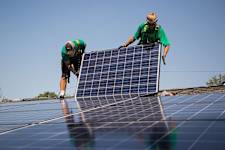While the peak is still widely recognized to be on Sept. 10, other dates have been considered.
By Zachary Rosenthal, AccuWeather staff writer
There is no time of year more likely for a tropical system to be spinning in the Atlantic than Sept. 10, which is the climatological peak of the Atlantic Hurricane Season.
Around 50% of all Atlantic hurricane seasons since the dawn of the satellite era in 1966 have had at least one hurricane traveling across the basin on Sept. 10, according to Colorado State meteorologist Philip Klotzbach.
During the 2020 season, which set a record for the number of named storms that developed, there was not an active tropical cyclone in the Atlantic basin on Sept. 10. But the next day, Tropical Depression 19 formed and it would go on to strengthen into Hurricane Sally, which made landfall as a Category 2 storm in Alabama, exactly 16 years to the day after Hurricane Ivan hit the Alabama coast.
While the peak is still widely recognized to be on Sept. 10, other dates have been considered. Meteorologist Brian McNoldy, who works as a researcher at the University of Miami, has carefully analyzed the question and considered numerous factors, and concludes that the peak occurs within the first two weeks of September -- depending on what metrics are being considered.
When considering only named storms from 1991-2020, the new peak date would be Sept. 12 instead of Sept. 10, McNoldy found. Using a separate metric, the amount of Accumulated Cyclone Energy (ACE) measured in the basin, the peak shifts to Sept. 14. ACE is a measure of the intensity and duration of cyclones, with stronger, long-lasting storms accumulating more ACE.
AccuWeather Senior Meteorologist and Hurricane Expert Dan Kottlowski said he doesn't expect a changing climate to shift the peak date.

Astronaut Nick Hague, aboard the International Space Station, posted this photograph of Hurricane Dorian to Twitter on Sept. 2, 2019. Dorian is one of the most notorious September hurricanes of all time.
"Climate change will both lead to more early-season development and more late-season development due to warmer than normal sea surface temperatures," Kottlowski explained. "So the date for the middle of the season probably won’t change."
Klotzbach, whose specialty is studying the Atlantic basin, also does not foresee a change in the date on which the peak of hurricane season occurs. He told AccuWeather that he hasn't seen much evidence suggesting the peak of hurricane season could shift, even in the face of a warming climate.
However, there has been conjecture that hurricane season could be trending longer than the official six months that it currently covers. In fact, the National Hurricane Center is investigating the possibility of moving the official start of hurricane season to about two weeks earlier than its June 1 start date.
But Klotzbach said the peak is poised to stay about the same due to two key factors: warm water and wind shear.
"While Atlantic sea surface temperatures typically continue to warm until late September/early October, vertical wind shear starts to increase relatively quickly in late September, knocking down storm activity," he said, adding that this is especially pronounced in the eastern and central parts of the basin.

This image shows the average track density for tropical systems in the Atlantic between 1988 and 2018.
"September 10 is basically when you still have low vertical wind shear, plenty of moisture and increasing sea surface temperatures," Klotzbach continued. "The increasing vertical wind shear tends to dominate over the continued warming sea surface temperatures as you move later in September."
September has seen more Category 5 hurricanes than any other month by far, with 21 different storms achieving the highest measure on the Saffir-Simpson hurricane wind scale. August comes in at a distant second place, with seven Category 5 storms recorded.
The most recent storm to reach Category 5 status was Hurricane Lorenzo, which became the easternmost Category 5 hurricane on record in 2019.
Some of the Atlantic Basin's most notorious storms have made their wrath felt in September.

A map plotting the tracks of all 21 September Category 5 hurricanes from the NOAA Hurricane History database.
In September 2019, just a few weeks before Lorenzo, Hurricane Dorian, a Category 5 storm that reached a peak wind speed of 185 miles per hour. The storm formed in late August and began devastating the Bahamas on the last day of the month and the first few days of September. According to NOAA, Dorian was the strongest hurricane in modern history to make landfall in the Bahamas.
Next, Dorian tracked up the coastline of the southeastern United States and made landfall as a Category 2 hurricane in the Outer Banks of North Carolina, over Cape Hatteras.
In September 2017, Category 5 Hurricanes Irma and Maria tore through the Caribbean. Irma pummeled the Northern Leeward Islands, making direct landfall on Barbuda as a Category 5 storm while also devastating Puerto Rico before hitting the Florida Keys and southeastern Florida as a Category 4 hurricane. Hurricane Maria slammed into Puerto Rico as a Category 4 storm, causing widespread power outages and approximately 3,000 fatalities.

A satellite image of Hurricane Maria as it crossed over Puerto Rico in September 2017. (NASA)
Other notable storms that occurred in September include Hurricane Ike, which plowed into parts of Texas as a massive Category 2 hurricane with a storm surge one would expect from a much stronger storm; Hurricane Isabelle, which peaked as a Category 5 storm over the Atlantic Ocean before landfalling in North Carolina and bringing flooding rains and winds to parts of the mid-Atlantic; and Hurricane Hugo, which was the most damaging storm ever in South Carolina history when it made landfall as a Category 4 storm in 1989.
Hurricane season continues well beyond Sept. 10, with the season not officially ending until Nov. 30. Powerful storms regularly form in the latter weeks of September and into October, with a secondary peak in tropical development occurring around Oct. 15.
"The second peak is related to more frequent fronts reaching deeper into the tropics while sea surface temperatures remain warm and helping to trigger storm development," Kottlowski said.
The October peak is attributable to the counter-clockwise wind pattern known as the Central American Gyre that often sets up over Central America as the month progresses.

"This wind flow pattern helps to create more favorable conditions for tropical development in the southern and western Caribbean during the month of October where we see a greater number of storms developing in the basin at that time of the year," Kottlowski said.
Hurricane Wilma, the most intense storm ever recorded in the Atlantic basin, formed on Oct. 15, 2005, and strengthened into a monster Category 5 hurricane with winds of up to 185 miles per hour.
In 2020, Hurricane Eta made a rare November landfall in Nicaragua as a Category 4 hurricane before landfalling in Florida twice as a tropical storm on Nov. 9 and Nov. 12.
More to read:
Want next-level safety, ad-free? Unlock advanced, hyperlocal severe weather alerts when you subscribe to Premium+ on the AccuWeather app. AccuWeather Alerts™ are prompted by our expert meteorologists who monitor and analyze dangerous weather risks 24/7 to keep you and your family safer.







No comments:
Post a Comment